Rangers at Yankees, 1:07 p.m.
Phillies at Giants, 4:57 p.m.
* * *
Bob Timmermann writes at L.A. Observed’s Native Intelligence that people complaining about bad Dodger Stadium experiences goes back quite a ways.
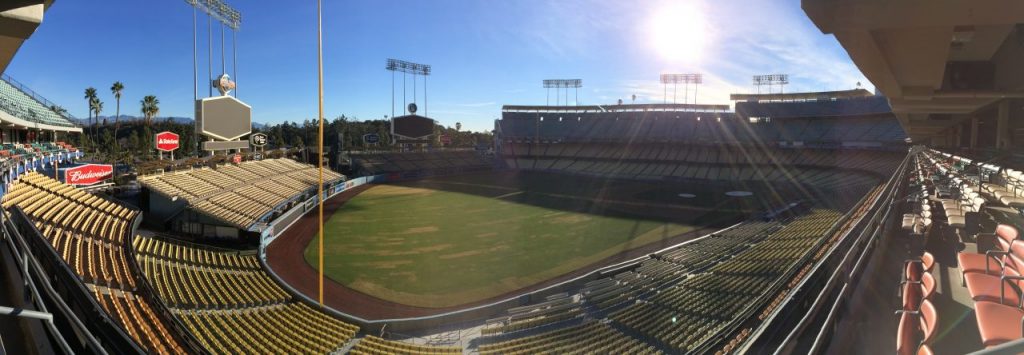
* * *
Bob Timmermann writes at L.A. Observed’s Native Intelligence that people complaining about bad Dodger Stadium experiences goes back quite a ways.
To celebrate today’s matchup between Tim Lincecum of the Giants and Roy Halladay of the Phillies, here’s a look at how Cy Young winners for the Dodgers performed in their postseason careers:
On the 22nd anniversary of “improbable … impossible,” here’s a link to Joe Posnanski’s post this week about 32 great calls in sports history. I’m amazed to say I was actually watching more than half of these as they aired: 32, 31, 27, 26, 24, 23 (no sound, in a bar), 22, 21, 20 (different announcer), 19, 18, 13, 12b (different announcer), 10c (different announcer), 9, 8, 5, 1.
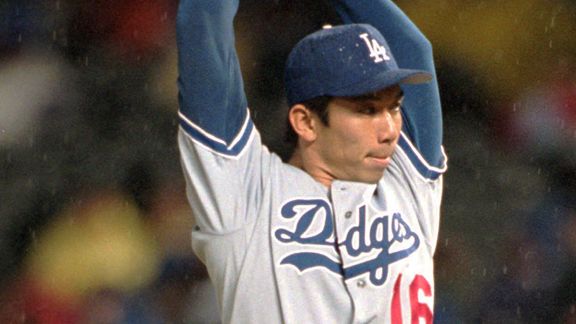
Robert Whiting, author of You Gotta Have Wa, is writing a detailed four-part series for the Japan Times on the impact Hideo Nomo had on baseball on both sides of the Pacific. So far, part one and part two have been published, and they are very good reads.
Here’s a sample:
… The Prime Minister of Japan hailed him as a national treasure. It was a remarkable turnaround, given that only months earlier, Nomo had been criticized heavily for deserting his team and his country. Ironically, Nomo received far more attention as a major leaguer than he ever had playing for the lowly Pacific League’s Kintetsu Buffaloes, who toiled before sparse crowds and hardly ever appeared on nationwide television.
One could even credit Nomo for helping to repair U.S.-Japan relations, which had been in tatters because of trade disputes.
Not so long before Nomo had arrived in America, the relationship was at a 40-year low. The speaker of the Japanese parliament had labeled Americans “uneducated and illiterate,” while American congressmen had been railing at Japan over “unfair trade practices” and its fanatical corporate warriors.
A group of U.S. congressmen had even smashed a Japanese car to pieces on the Capitol lawn. But the love affair of MLB fans with Nomo helped to dissipate the acrimony between the two countries.
Nomo was on the cover of Sports Illustrated and Time Asia and the subject of more than one TV documentary.
The New York Times noted with approval a shift in the mood in Japan. “Nomo’s arrival in MLB,” wrote that prestigious newspaper, “signifies that the Japanese penchant for closed door exclusivity is receding.”
The Asahi Shimbun called Nomo’s success a “catharsis” for Japanese who were weary of the constant carping of the U.S. government over trade.
Nomo’s appearance in the 1995 All-Star Game in Arlington, Texas, was an historically significant moment, coming as it did almost exactly a half-century after the end of the Pacific War between Japan and the United States, and no one watching could escape its significance. A player from Japan had emerged to reignite the national pastime in a way that perhaps no native-born American could have, given the bitter emotions that remained over the strike.
He brought back all the feelings that baseball players used to inspire. He was modest, humble, shy, hardworking and a joy to watch on the field. That last sentence could have been used to describe a Christy Mathewson, Lou Gehrig or a Joe DiMaggio. It made Americans and Japanese stop and contemplate baseball’s role in cross-cultural relations. …
Of course, not all was sweetness and light. Occasionally, nationalism and even prejudice reared its ugly head. …
(Thanks to Brett Bull for the tip.)
* * *
Vin Scully Is My Homeboy passed along video of an old Hollywood Stars Night at Dodger Stadium from the 1960s, starting with a combo of Walter Alston and Phyllis Diller, followed by Milton Berle, Dean Martin, Mickey Rooney, Annette Funicello, Billy Barty and more. See if Nancy Sinatra’s boots are made for walking to first base …
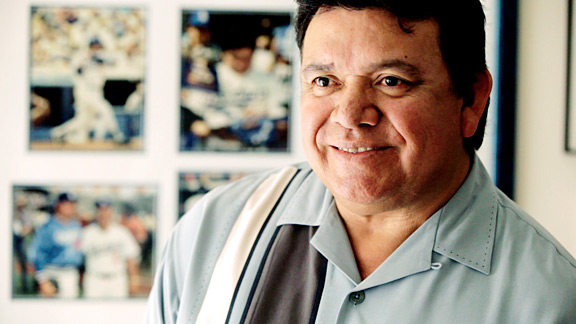
ESPN’s strong “30 for 30” sports documentary series finds its way to Fernandomania on October 26 with “Fernando Nation,” directed by Cruz Angeles. Here’s the set-up, courtesy of the ESPN press release:
“ ‘The Natural’ is supposed to be a blue-eyed boy who teethed on a 36-ounce Louisville Slugger. He should run like the wind and throw boysenberries through brick. He should come from California.” – Steve Wulf, Sports Illustrated, 1981.
So how was it that a pudgy 20-year-old, Mexican, left-handed pitcher from a remote village in the Sonoran desert, unable to speak a word of English, could sell out stadiums across America and become a rock star overnight? In “Fernando Nation,” Mexican-born and Los Angeles-raised director Cruz Angeles traces the history of a community that was torn apart when Dodger Stadium was built in Chavez Ravine and then revitalized by one of the most captivating pitching phenoms baseball has ever seen. Nicknamed “El Toro” by his fans, Fernando Valenzuela ignited a fire that spread from L.A. to New York—and beyond. He vaulted himself onto the prime-time stage and proved with his signature look to the heavens and killer screwball that the American dream was not reserved for those born on U.S. soil. In this layered look at the myth and the man, Cruz Angeles recalls the euphoria around Fernando’s arrival and probes a phenomenon that transcended baseball for many Mexican-Americans. Fernando Valenzuela himself opens up to share his perspective on this very special time. Three decades later, “Fernandomania” lives.
To be clear, the tearing apart of the community in Chavez Ravine began long before Dodger Stadium entered the picture (see Chapter 11 of “100 Things Dodgers Fans Should Know & Do Before They Die”). In any case, I’m really looking forward to this special.
That Steve Wulf story, by the way, was published in March — a rare national acknowledgment of the potential Valenzuela had before his memorable 1981 season began. Here’s another excerpt: “Valenzuela was born Nov. 1, 1960 in Navojoa on the west coast of Mexico. The Dodgers know this because (Al) Campanis sent Mike Brito, the scout who signed Valenzuela, to Navojoa to pick up his birth certificate. ‘I knew nobody would believe how young he was, unless we got some proof,’ says Campanis.”
* * *
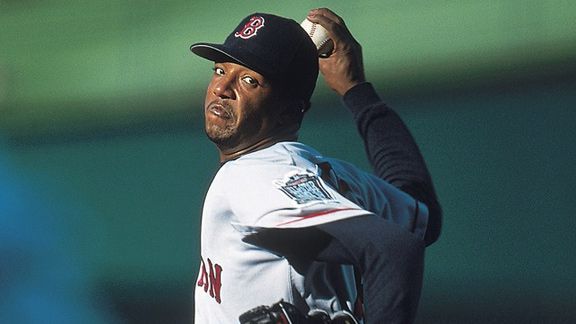
My lack of anticipation for “The Tenth Inning,” Ken Burns’ and Lynn Novick’s four-hour sequel (airing in two parts Tuesday and Wednesday on PBS) to Burns’ 1994 documentary, “Baseball,” could hardly have contrasted more to how eager I was to see the original.
That 18-hour documentary came out when Burns’ glorious “The Civil War” was still fresh in my mind, came out during the work stoppage that caved in the 1994 baseball season and, perhaps most importantly, largely featured material from the distant past. Buck O’Neil, to whom “The Tenth Inning” is dedicated, made “Baseball” worthwhile all by himself.
By contrast, I wasn’t in any hurry to relive post-1993 baseball via the Burns treatment. I didn’t feel I had enough distance. (On top of that, “Tenth” figured to be exceedingly light on Dodger content, providing a reminder of how absent Los Angeles has been from baseball relevance for most of the past two decades.)
That latter concern was certainly borne out, but I will tell you that I did enjoy “Tenth” a bit more than I expected, with Burns (along with co-writers David McMahon and Novick) showing that at times, he can still deliver the goods.
It’s true that it’s tough to be a Dodger fan watching this program. Basically, the best one can do is take in the homage to Pedro Martinez and recall the time when he was ours, or take in the homage to Dave Roberts’ World Series steal and recall the time when he was ours. Furthermore, I felt personally insulted by the documentary’s suggestion that “no Latin player, not even (Roberto) Clemente or the Dodgers’ great Mexican pitcher of the 1980s, Fernando Valenzuela, had ever before received such an outpouring of affection and admiration” as Sammy Sosa.
But I did enjoy revisiting recent baseball history – being transported back to Fernando Cabrera’s pennant-clinching hit or seeing names like Tony Gwynn celebrated once again – more than I expected.
“Tenth” also did a better job than I feared injecting nuance into the discussion of performance-enhancing drugs, a topic that permeates the four hours. Through its sources and narrator Keith “Goliath” David, “Tenth” provides a brief history of cheating in baseball, knocking down some of the holier-than-thou aspects of the debate, and explaining why, even as suspicions rose, people didn’t really want to investigate.
“Innocence is beautiful, sometimes,” Martinez says memorably.
And though Barry Bonds’ story was somewhat sadly tiresome, the set-up wasn’t: a focus on Bonds’ father Bobby and how his troubled career shaped Barry, yielding the person who would stare unabashedly into the face of the disgust directed toward him:
“Boo me! Cheer me!” Bonds exclaims at a press conference. “Those that are gonna cheer me are gonna cheer me; those that are gonna boo me are gonna boo me. So what. But they’re still gonna come see the show. … Dodger Stadium is the best show that I go to in all my life in baseball. They say ‘Barry sucks!’ louder than anybody out there. And you know what, you’ll see me in left field (encouraging them), because you know what, you’ve got to have some serious talent to have 53,000 people say ‘You suck.’ I’m proud of that.”
There are moments when “Tenth” goes beyond the obvious to tell its stories, and those moments are pretty great.
However, particularly in the second part, there are also extended stretches in which the storytelling fails to reach any kind of height, stretches in which the storytelling is completely conventional, no more special than a run-of-the-mill sports documentary that gets thrown together without such fanfare. Because of this, I think that “The Tenth Inning” will be appreciated more by the casual fan than the dedicated fan (and, of course, enjoyed much more by fans of the teams depicted than the teams ignored).
“As its flaws become apparent, (baseball) actually gains depth and humanity, even as it loses its fairy-tale, mythic qualities,” says sportswriter Thomas Boswell, who quietly emerges as perhaps the best on-screen voice of the documentary. Burns and his team get this concept, and I’m glad. The tone to the conclusion of 240-minute endeavor couldn’t be more appropriate. I just wish “The Tenth Inning” had pursued more off-the-beaten path stories, stories like Buck O’Neil and Bobby Bonds, than spending so much time on the more familiar recent history that feels like it’s been sitting on a warming tray.
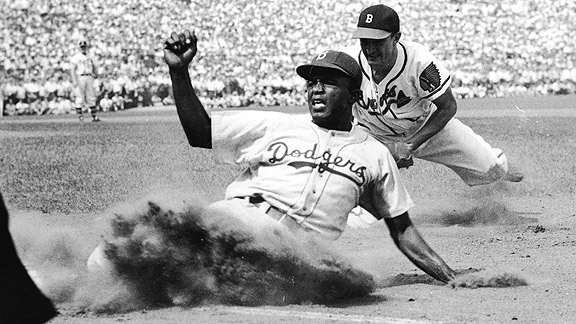
While poking around the Dodgers’ all-time seasonal sacrifice hit leaders Friday to come up with the tidbit on Clayton Kershaw, I noticed that Jackie Robinson had the bold-face total of 28 in his rookie year, 1947. (I mentioned this in the comments section, but felt it trivially interesting enough for a separate post.)
Times were different then, obviously, but I still found it rather stunning. This was a year in which Robinson hit .297 with 74 walks and 48 extra-base hits and led the National League in stolen bases. He grounded into five double plays in 590 at-bats. There probably weren’t many hitters for whom the sacrifice was more of a waste than Robinson. Yet there he was, squaring up more than anyone around.
In fact, in a 15-game stretch from August 10-23, during which Robinson OPSed .998, someone thought it’d be a good idea for him to sacrifice bunt eight times. My way of putting that in perspective: Robinson had more sacrifice hits in those two weeks than Rickey Henderson had in 1,746 games from 1981-93.
It was a long time ago, but I wonder if there was anyone who noticed Robinson was red-hot at the plate and wondered when they were going to stop making him give himself up.
* * *
My favorite part of Arash Markazi’s ESPNLosAngeles.com column on Manny Ramirez’s return to Southern California:
Dodgers organist Nancy Bea Hefley and her husband, Bill, drove down to Anaheim to catch up with Ramirez and (Juan) Pierre, before leaving for their home in northern Nevada prior to the opening pitch.
“When Manny arrived, the team wasn’t doing anything and he just brought a spark,” said Hefley, who gave Ramirez and Pierre a big hug each in the visitor’s dugout. “He brought a spark to the team in the dugout and on the field and made it very exciting.” …
* * *
Shades of Randy Wolf: Ted Lilly should clearly be offered salary arbitration after this season, though he will probably turn said offer down, writes Mike Petriello of Mike Scioscia’s Tragic Illness.
Petriello also passes along this note from Mark Whicker of the Register that outfield prospect Jerry Sands will experiment at third base in the Arizona Fall League. Whicker’s main point in his column is that the Dodgers shouldn’t give up on their homegrown core, despite this year’s frustrations.
Today, the Baseball Reliquary is celebrating the 40th anniversary of Jim Bouton’s “Ball Four” with six hours of events at the Burbank Central Library.
Bouton, Tommy Davis and others will be on two panels taking place, beginning at 11 a.m. Baseball Reliquary executive director Terry Cannon recommends you arrive at 10:30 a.m., and notes that posted parking time limits are being waived at “a small lot which adjoins the library, and a larger lot across the street on Glenoaks and Olive (entrance on Olive).”
Click the links above for more details – could be a tremendous way to spend your Saturday.
Jay Gibbons is batting cleanup tonight for the third time as a Dodger. That would not have seemed likely a month ago, but Gibbons is far from the most unlikely Dodger cleanup hitter of the past seven seasons. Who’s your favorite from this list?
Dodger cleanup hitters since 2004
2010: James Loney (50 games), Matt Kemp (43), Manny Ramirez (41), Casey Blake (7), Jay Gibbons (3), Andre Ethier (2).
2009: Blake (43), Ethier (42), Kemp (27), Ramirez (26), Loney (21), Russell Martin (3).
2008: Jeff Kent (74), Loney (28), Ramirez (25), Martin (18), Blake (8), Ethier (3), Nomar Garciaparra (3), Andruw Jones (2), Mark Sweeney (1).
2007: Kent (132), Luis Gonzalez (20), Loney (6), Martin (1), Mike Lieberthal (1), Olmedo Saenz (1), Shea Hillenbrand (1)
2006: J.D. Drew (83), Kent (59), Saenz (7), Ethier (5), Garciaparra (3), Kemp (2), Loney (1), Joel Guzman (1), Ricky Ledee (1).
2005: Kent (110), Saenz (26), Ledee (10), Jason Phillips (8), Jose Cruz, Jr. (3), Jayson Werth (2), Hee-Seop Choi (1), Mike Edwards (1), Milton Bradley (1).
2004: Adrian Beltre (92), Shawn Green (63), Milton Bradley (3), Saenz (2), Juan Encarnacion (1), Robin Ventura (1).
* * *
Al LaMacchia, the 1940s major-leaguer who became a scout for six decades thereafter, finishing up with the Dodgers, has passed away at the age of 89.
Bill Plaschke of the Times shone a light on LaMacchia when he talked about the scout’s recommendation that the Dodgers acquire Andre Ethier — a column that (and I certainly mean no disrespect to LaMacchia) inspired this response from Fire Joe Morgan.
My most sincere condolences to LaMacchia’s family and friends.
* * *
Today is the 30th anniversary of Fernando Valenzuela’s major-league debut, notes Eric Stephen of True Blue L.A. The Dodgers will pay tribute to the occasion on Sunday’s game.
Let me introduce you to a really cool website, CriticalPast.com (which I found via Baseball Think Factory). It offers all kinds of historic film footage — here’s a link to what comes up under a Dodgers search. For example: a quick newsreel peek at the Dodgers during Spring Training, 1953. I’ve also gotten lost looking up various old pieces of Los Angeles history.
* * *
Dodger manager Joe Torre, who has indicated he wanted to play the most competitive Dodger lineup in remaining games against contenders, chose lefty-hitting Jay Gibbons at first base over lefty-hitting James Loney against lefty San Francisco pitcher Barry Zito. Loney is 2 for 26 with no walks in his career against Zito. Gibbons is 3 for 15 with a double and two walks.
Using this criteria, Torre ran out of options somewhat quickly.
* * *
Late add: the 2011 tentative Dodger schedule. Season opener on April Fool’s Day at home against the Giants. It’s the first Friday opener for the Dodgers in 32 years, Tony Jackson writes – changes things up, but I kind of don’t mind it.
It has been seven years since this piece was first published: September 11, 2003. A lot has happened since then – including a very happy September 18, 2006. But this game will always remain special, and I hope you don’t mind me continuing to remember it on this date.
* * *
Twenty years ago today, Dodger Stadium hosted its greatest game.
It began swathed in bright blue skies and triple-digit temperatures. When it ended, 228 crazy brilliant minutes later, shadows palmed most of the playing field, and every Dodger fan who witnessed the spectacle found themselves near joyous collapse.
The game was between the Dodgers of Steve Sax and Pedro Guerrero, of Greg Brock and Mike Marshall … and the Braves of Dale Murphy, of Bruce Benedict, of Brad Komminsk.
In the end, however, it came down to one man. A rookie named R.J. Reynolds.
The analogy doesn’t quite work, but the above was the best I could come up with for the latest result. Los Angeles got a rare first-inning lead on Andre Ethier’s two-run homer, but gave it up for good on a three-run homer by Houston third baseman Chris Johnson in the sixth inning. The Dodgers lost their sixth straight game and fell to 69-72.
Only four Dodger teams have finished below .500 since 1988. According to my research on Baseball-Reference.com, no Dodger team has ever entered September with a winning record and finished the season with a losing record.
Sandy Koufax was Sports Illustrated’s 1965 Sportsman of the Year. Dodger Thoughts friend Stan from Tacoma passes along the massive interview Koufax did for the issue, which begins thusly:
Sandy, what’s the difference between the way you manage your life and the way anybody else would manage his?
–I don’t do anything different. I do the things that most people do. There are times when I feel like I have an obligation not to do certain things because I’m preparing myself to pitch. But other than that my life is about as normal as I can keep it.
Yes, but you have this reputation for being awfully hard on yourself.
–Maybe I am. I know sometimes people’ll say, “Well, you’ve done everything possible, what’re you gonna do next? You can’t pitch a better ball game.” And I say to myself, “Well, why not? Why can’t I do more, why can’t I do a better job?” There’s nothing to stop me — except the hitters. You can always try to pitch a better ball game, the best you possibly can.
Sandy, I’ve seen you after you’ve pitched and you sit at your locker and you look like World War II. At this stage of your career isn’t there any tendency on your part to jake it a little, not to put out quite so much?
–I can’t. I can’t. Sometimes you get enough runs and you try to take it easy and all of a sudden you’re in trouble.
Yes, but you go out there and work like a guy who’s expecting to be cut right after the game.
–You’ve got to put out on every pitch. How do you know what the other pitcher’s going to do? He’s out there trying to get your team out, too. People say, doesn’t it make you a better pitcher because your team doesn’t score runs, doesn’t that make you bear down? Well, the Dodgers score more runs than people think, but even if your ball club scores a lot of runs I don’t think you can take the attitude that you can give up two or three runs and still win. You’ve got to say to yourself, “I don’t know how many I’m gonna get, but if I can keep the other side from scoring any I have a lot better chance.” So you put out on every pitch. …
* * *
Ryan Howard was ejected in the 15th inning of tonight’s Phillies-Astros game, forcing Philadelphia to use pitcher Roy Oswalt in left field.
From 100 Things Dodgers Fans Should Know & Do Before They Die:
Suspended Animation
Lest it be forgotten, the Dodgers also tried to burn the midnight oil one time in Chicago – but that was back when Wrigley Field had no midnight oil to burn. On August 16, 1982, the Dodgers and Cubs played 17 innings of a 1-1 tie before umpires suspended the game due to darkness. It resumed the following day with the Dodgers winning 2-1 in 21 innings.“The guys who had already been in the game were cheering the other guys on,” Rick Monday told Mark Heisler of the Los Angeles Times. “Someone made the observation that it was like a Pony League game. We were going, ‘Hey batter, batter, batter!’ all the way to ‘Pitcher’s got a rubber arm!’ Yeah, we were a little nuts.”
So was the Dodgers defense. Fernando Valenzuela logged time in the outfield after Ron Cey’s ejection in the 20th inning left the team one player short. But in the top of the 21st, Steve Sax scored on a sacrifice fly that saw umpire Eric Gregg raise his arm to call out before switching to the safe sign midway through. Bob Welch entered the game in the bottom of the 21st as, of all things, a defensive replacement for Valenzuela, and Jerry Reuss finished his fourth inning of shutout ball to win in relief — just before throwing five innings in the regularly scheduled game, a 7-4 Dodger victory, to grab that decision as well.
Page 32 of 35
What happens when three old friends in crisis fall into an unexpected love triangle? In The Catch, Maya, Henry and Daniel embark upon an emotional journey that forces them to confront unresolved pain, present-day traumas and powerful desires, leading them to question the very meaning of love and fulfillment. The Catch tells a tale of ordinary people seeking the extraordinary – or, if that’s asking too much, some damn peace of mind.
Brothers in Arms excerpt: Fernando Valenzuela
October 22, 2024
Catch ‘The Catch,’ the new novel by Jon Weisman!
November 1, 2023
A new beginning with the Dodgers
August 31, 2023
Fernando Valenzuela: Ranking the games that defined the legend
August 7, 2023
Interview: Ken Gurnick
on Ron Cey and writing
about the Dodgers
June 25, 2023
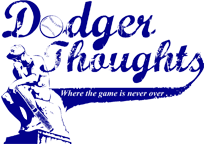
Thank You For Not ...
1) using profanity or any euphemisms for profanity
2) personally attacking other commenters
3) baiting other commenters
4) arguing for the sake of arguing
5) discussing politics
6) using hyperbole when something less will suffice
7) using sarcasm in a way that can be misinterpreted negatively
8) making the same point over and over again
9) typing "no-hitter" or "perfect game" to describe either in progress
10) being annoyed by the existence of this list
11) commenting under the obvious influence
12) claiming your opinion isn't allowed when it's just being disagreed with
1991-2013
Dodgers at home: 1,028-812 (.558695)
When Jon attended: 338-267 (.558677)*
When Jon didn’t: 695-554 (.556)
* includes road games attended
2013
Dodgers at home: 51-35 (.593)
When Jon attended: 5-2 (.714)
When Jon didn’t: 46-33 (.582)
Note: I got so busy working for the Dodgers that in 2014, I stopped keeping track, much to my regret.
Powered by WordPress & Theme by Anders Norén